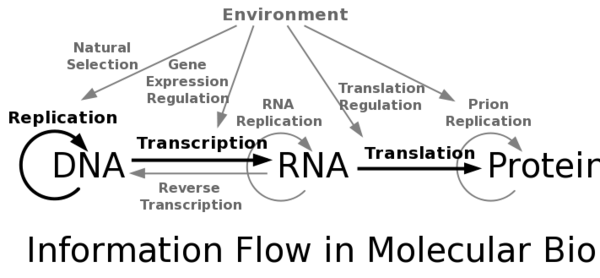Central Dogma
Information in molecular biology flows from DNA, which is replicated, to RNA by transcription, and then polypeptide sequence by translation. The canonical central dogma of molecular biology is shown in black in the image above. There are exceptions to this information flow such as reverse transcription from RNA to DNA and RNA replication, both are found in some viruses and retrotransposons. There is also the replication of prion protein structures which in some cases, as found in some fungi, can transmit information. Signals from the biotic and abiotic extracellular environment also constitute a major source of information that influences all of these steps. Information flow that is not part of the central dogma is graphed in gray.
This is not to imply that all DNA is transcribed into RNA nor that all RNA is translated into proteins. The majority of DNA in eukaryotic genomes is not transcribed, DNA can have a function in its own right (such as sequences important to chromosomal structure), and many RNA's carry out their functions without being translated into proteins.
DNA-DNA, DNA-RNA, DNA-protein, RNA-RNA, RNA-protein, and protein-protein interactions are all necessary mechanisms to carry out these steps of information flow.
